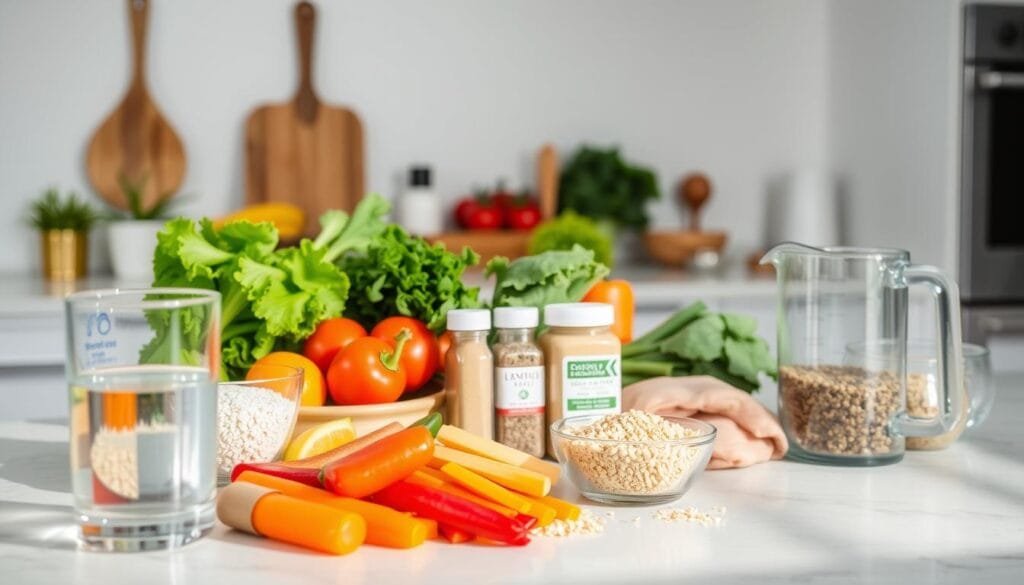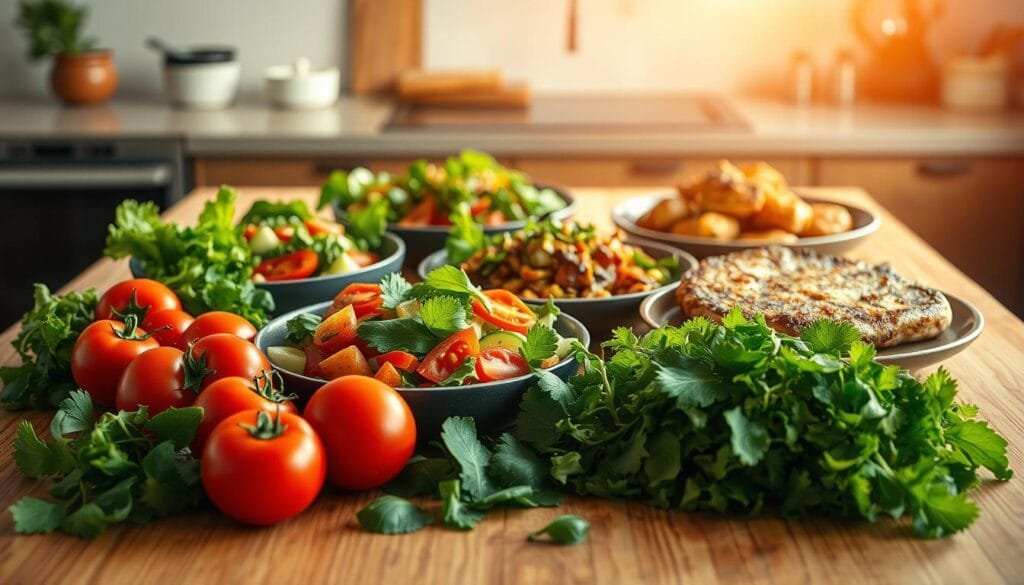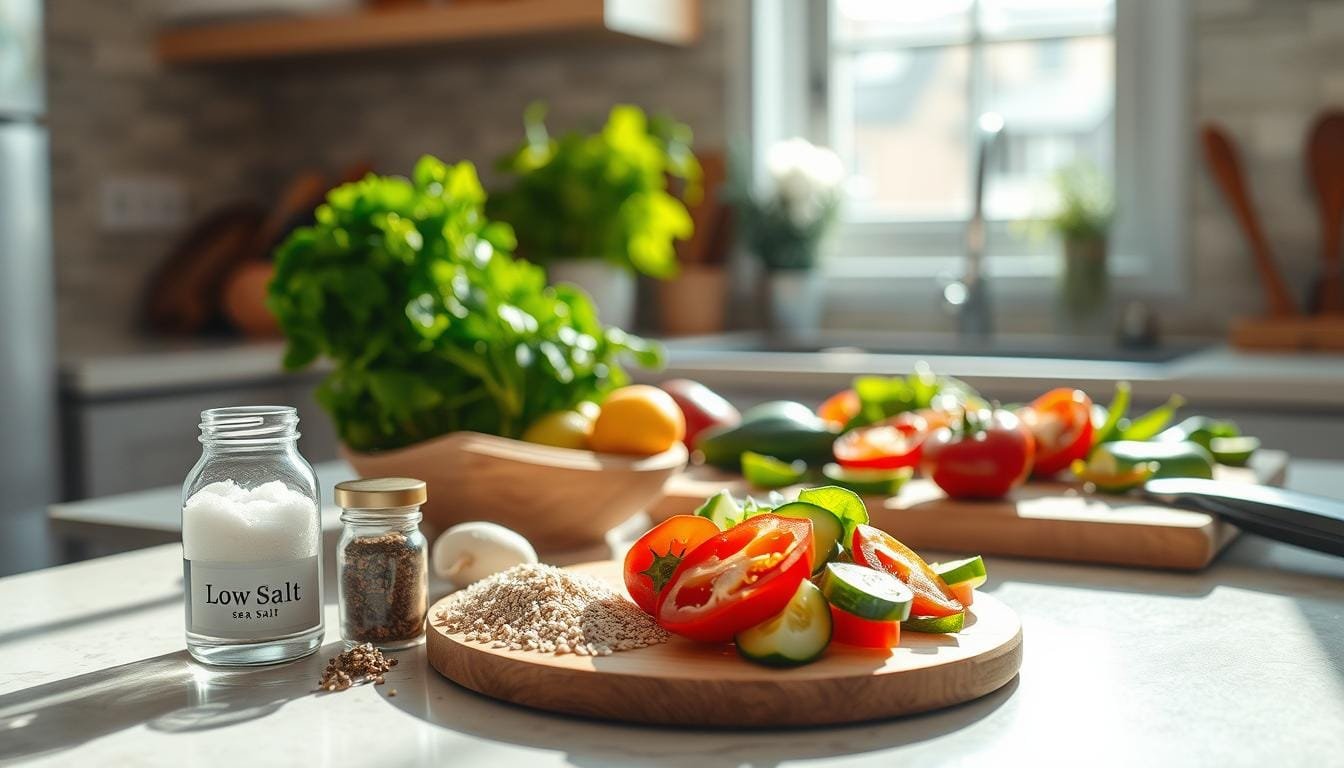It’s easy to overlook how much sodium we eat every day. But, Americans take in 50% more sodium than we should. This can raise our blood pressure and harm our kidneys. Learning how to eat a low sodium diet is tough, but it’s doable with the right tips. It helps lower blood pressure and cuts down on kidney disease risks.
By following simple guidelines, we can greatly improve our health. This article will show why cutting down on sodium is key. We’ll give 7 easy tips on how to eat a low sodium diet. Topics include understanding sodium’s health effects and cooking tasty meals without salt.
Key Takeaways
- Reducing sodium intake can help lower blood pressure and reduce the risk of kidney disease
- Americans consume 50% more sodium than the recommended daily quantities
- Fresh fruits, vegetables, and meats are naturally low in sodium and high in nutrients
- Understanding how to eat a low sodium diet is essential for our health
- By following low sodium diet tips, we can make a significant impact on our health and well-being
- Reducing sodium intake can lower the risk of developing heart disease, including heart failure and ischemic heart disease
Understanding the Impact of Sodium on Your Health
Sodium is a key mineral our bodies need. But too much can cause high blood pressure, heart disease, and stroke. The American Heart Association says we should not eat more than 2,300 milligrams of sodium daily. To meet this goal, it’s important to know the benefits of eating less sodium and follow guidelines.
Eating less sodium can lower blood pressure and reduce heart disease risk. It also helps lower the chance of stroke and kidney disease. By choosing the right foods and following guidelines, we can cut down on sodium and get healthier.
To eat less sodium, try cooking meals from scratch and using fresh veggies. Opt for low-sodium foods instead of processed ones. Always check food labels for sodium content. By doing these things, we can enjoy the health benefits of eating less sodium.
Check This:
- Easy Mediterranean Diet Sample Menu: Delicious & Healthy
- How to Follow the Mediterranean Diet Meal Plan
How to Eat a Low Sodium Diet: Essential Guidelines
To keep your sodium levels healthy, follow some key tips. The National Kidney Foundation suggests eating fresh fruits, vegetables, whole grains, and lean proteins. Try to eat less than 2.3 grams (2300 milligrams) of sodium each day. This can be done by adding healthy low sodium recipes to your meals.
Being careful about what you eat is part of low sodium meal planning. Most of our sodium comes from processed foods. Fresh fruits and veggies are great because they have little sodium. The DASH diet says to eat four to five servings of fruit and veggies every day. You can also use low-sodium canned beans and peas instead of regular ones.

When you go shopping, look for low-sodium foods. Many stores now label healthy options. Always check food labels for sodium content. Choose items with 200 milligrams of sodium or less per serving. Ready-to-eat meals should have 600 milligrams of sodium or less. By following these tips and using healthy low sodium recipes, you can keep your diet balanced and lower your sodium intake.
Lowering sodium can help lower your blood pressure by 2 to 3 mmHg. Over time, this can lead to a drop of up to 10 mmHg. Making smart food choices and following low sodium diet tips is a great start to a healthier life. Don’t forget to drink plenty of water, limit alcohol, and watch your caffeine intake for better health.
Smart Shopping Strategies for Low Sodium Foods
Shopping smart is key when choosing low sodium foods. Most sodium comes from prepared, packaged, and restaurant foods. Knowing this, we can make better choices. The FDA helps by listing sodium on labels, guiding us to healthier options.
To begin, reading labels is a must. Look for “low sodium” or “reduced sodium” labels, which mean less than 140 milligrams per serving. Check the ingredient list for sodium like salt, soy sauce, and monosodium glutamate. Also, watch out for hidden sodium in canned goods, processed meats, and condiments.
Opt for fresh fruits, unseasoned meats, and whole grains. These are naturally low in sodium. Remember, even low-sodium foods can add up if we eat too much of them.
Being aware of sodium in our food choices is the first step to better health. Always check labels, choose low-sodium options, and watch your portions. This way, we can enjoy healthier, low sodium foods.
| Food Label | Sodium Content |
|---|---|
| Salt-free or sodium-free | Less than 5 milligrams per serving |
| Very low sodium | Less than 35 milligrams per serving |
| Low sodium | Less than 140 milligrams per serving |
Preparing Flavorful Meals Without Salt
Reducing sodium intake is key to a healthier lifestyle. You can do this by making tasty meals without salt. Herbs and spices are great for adding flavor without salt, making them perfect for healthy low sodium recipes. They help in creating delicious, nutritious meals that are good for reducing sodium intake.
Basil, oregano, and thyme are popular herbs that can spice up your meals. You can also use marinades and other seasonings to add flavor without salt. For instance, a mix of olive oil, lemon juice, and herbs makes a tasty marinade for your favorite dishes.

Using acids like citrus fruits and vinegars also adds flavor to meals. They bring brightness and taste to your dishes without salt, making them great for healthy low sodium recipes. By using these tips and planning your meals with low sodium meal planning, you can make tasty, healthy meals that help reduce sodium intake.
Here are some tips for making flavorful meals without salt:
- Use herbs and spices to add flavor to your meals
- Use marinades and other seasonings to add flavor to your meals
- Use acids such as citrus fruits and vinegars to enhance the flavor of your meals
By following these tips, you can make delicious, nutritious meals. These meals are perfect for reducing sodium intake and improving your health.
Making Smart Choices When Dining Out
Eating out can be tough on a low sodium diet, but it’s doable with the right approach. The National Kidney Foundation suggests asking for sauces and seasonings on the side. This simple trick can greatly reduce sodium and boost your health.
Keeping sodium intake low is key for good health. By choosing wisely and being aware of how food is made, you can enjoy dining out healthily. Opt for grilled or baked foods, pick steamed veggies, and cut down on processed meats and cheeses.
- Choose restaurants that offer low-sodium options or are willing to accommodate special requests
- Avoid adding extra salt or seasonings to your food
- Opt for whole-grain options instead of refined grains
- Limit your intake of high-sodium foods like soups, sauces, and condiments
By following these tips and being mindful of sodium, you can enjoy dining out while staying healthy. Always ask about your meal’s ingredients and preparation. And don’t hesitate to ask for special dietary needs to be met.
Conclusion: Embracing a Healthier Lifestyle Through Low Sodium Living
Starting a low-sodium diet is a simple way to boost your health. It can help lower your blood pressure and reduce the risk of kidney disease. This article has given you guidelines and strategies to make healthier food choices and control your sodium consumption.
A low-sodium diet is good for your heart and kidneys. It also helps keep your bones strong by preventing calcium loss. With a bit of planning, you can add low-sodium foods to your daily meals. This leads to a healthier lifestyle.
So, take control of your health. Start a low-sodium diet for a brighter, healthier future.
Source Links
- https://www.kidney.org/news-stories/top-10-tips-reducing-salt-your-diet – Top 10 Tips for Reducing Salt in Your Diet
- https://www.nhlbi.nih.gov/news/2023/halt-salt-5-ways-cut-down-sodium-and-improve-your-heart-health – Halt the Salt: 5 Ways to Cut Down on Sodium and Improve Your Heart Health

